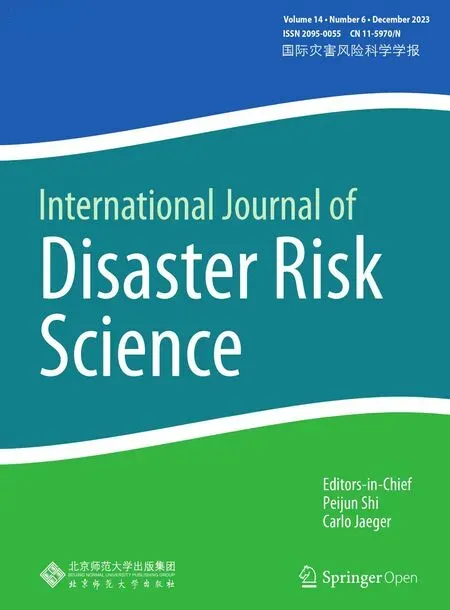A Two-Stage Evolutionary Game Model for Collaborative Emergency Management Between Local Governments and Enterprises
2023-02-26YanqingWangHongChenXiaoGu
Yanqing Wang · Hong Chen · Xiao Gu
Abstract Enterprises play a vital role in emergency management, but few studies have considered the strategy choices behind such participation or the collaborative relationship with the government.This study contended that enterprises have at least three strategies regarding emergency management: non-participation, short-term participation, and long-term participation.We constructed a two-stage evolutionary game model to explore the behavioral evolution rules and evolutionary stability strategies of the government and enterprises, and employed numerical simulation to analyze how various factors inf luence the strategy selection of the government and enterprises.The results show that if and only if the utility value of participation is greater than 0, an enterprise will participate in emergency management.The evolutionary game then enters the second stage,during which system stability is af fected by a synergistic relationship between participation cost, reputation benef it, and government subsidies, and by an incremental relationship between emergency management benef it, government subsidies, and emergency training cost.This study provides a new theoretical perspective for research on collaborative emergency management, and the results provide important references for promoting the performance of collaborative emergency management.
Keywords Collaborative relationship · Emergency management · Enterprise participation · Numerical simulation · Twostage evolutionary game
1 Introduction
The mounting frequency and intensity of various emergencies are placing increased pressure on emergency management (Bosomworth et al.2017), and the traditional government-centered system struggles to respond ef fectively.To improve the market mechanism and give full play to its ef ficiency, professionalism, and competitiveness, market participation in emergency management is imperative(Nan et al.2022).In many countries, enterprises, non-prof it organizations, and residents have played an important role in such work.The general trend of emergency management worldwide has been to advocate collaboration between governments, social organizations, enterprises, and the residents (Kong and Sun 2021; Fan et al.2022).
Collaborative emergency management (CEM) has been def ined as joint activity of two or more stakeholders that work together in pursuit of greater public good.It aims to eliminate wasted resources and ef forts via communication,coordination, and interoperability (Kapucu et al.2010).With the complexity of emergencies continues to increase, the success of emergency management becomes increasingly depending on ef fective collaboration (Oh et al.2014).The September 11 attacks in 2001 and Hurricane Katrina in 2005 have been followed by a signif icant increase in the role of social forces in emergency management (Lv 2017).In particular, private enterprises have made great contributions by enhancing their advantages in capital, technology, and equipment.For example, Walmart and Home Depot implemented ef fective relief ef forts in responding to Hurricane Katrina, combining proactivity with logistic expertise (Wang et al.2014).During the Covid-19 pandemic, Meituan provided people with many kinds of food, necessities, medicines, epidemic prevention and disinfection supplies, and other errand services, thereby deploying its professional capabilities to provide necessary guarantees for people’s live (Zhang 2021).According to the 2020 Meituan Delivery Action Report against COVID-19, Meituan’s order volume reached 3.96 million during the lockdown of Wuhan,with 54.1% of Meituan riders delivering orders to hospitals.Meituan took the lead in launching a “contactless delivery”service, which played an important role in avoiding contact infection.Each enterprise has unique advantages, and the strong “joint force” they can form is increasingly important when dealing with emergencies, ef fectively mitigating inadequacies of government provision in emergency management.
The above illustrates that enterprises have become an important actor in emergency management.Government failures in emergency response and the greater ef ficiency of the private sector further ref lect enterprises’ important functions (Linnenluecke and McKnight 2017).However,enterprises participating in emergency management continue to self-organize, rather than being included in the government response system (Zhang and Tong 2015).Previous studies have focused mostly on the emergency management capability of public organizations, such as the government and schools (Shi 2012; Shah et al.2018), while giving little attention to private organizations.In particular, the greater ef ficiency of enterprises’ participation in emergency management through the market mechanism has scarcely been explored.Therefore, this study aimed to analyze the strategy choices and game relationship between local governments and private enterprises, and to explore what incentives promote CEM performance.Our f indings will have important theoretical and practical significance for promoting the establishment of a sustainable, ef fective CEM system and improving capabilities.
2 Literature Review
This section introduces related works about CEM and evolutionary game theory, discusses gaps in the literature, and explains why we used evolutionary game method and system dynamics (SD) simulation in this study.
2.1 Related Works on Collaborative Emergency Management (CEM)
Due to the increasing frequency and severity of large-scale disasters worldwide, since the beginning of the twenty-f irst century, particularly following the September 11 attacks in 2001, multi-agent CEM for cross-border and major crises has become a hot topic among scholars (Ansell et al.2010; Hart 2013).Multi-agent collaboration in emergency management has three main aspects: collaboration between the government, the market, and social organizations (Diehlmann et al.2021); collaboration between governments at dif ferent levels and in dif ferent regions (vertical and horizontal) (Li 2017);and collaboration between dif ferent functional agencies at the same government level (Bennett 2018).Previous studies focused mainly on the synergistic relationship between government emergency management departments and social organizations.For example, Tau et al.( 2017) analyzed the CEM between dif ferent countries in the Southern African Development Community (SADC).Olszewski and Siebeneck ( 2021) discussed the nature of CEM between dif ferent levels of government in the United States, and proposed a framework visualizing collaboration as a trust-building and outcome cycle.Chen et al.( 2019b) revealed the functions of social organizations in natural hazard-related disasters’emergency relief, and analyzed their role orientation in the emergency management network.Elsewhere, the role of emerging technologies in promoting CEM capabilities has also attracted widespread scholarly attention.For example,Wang and Chen ( 2022) clarif ied the possibility of using blockchain technology to improve the ef ficiency of multiagent CEM with respect to information sharing, supervision,and reward/punishment.Xiong and Xue ( 2023) analyzed the feasibility of using blockchain to improve the performance of emergency material collaborative transportation.Gupta et al.( 2022) put forward an evidence-based framework that emphasizes the role of artif icial intelligence and cloud-based collaboration platforms in emergency management.
In terms of enterprises’ participation in emergency management, previous studies have mainly focused on enterprises’ own emergency management capability and role.For example, Li et al.( 2021) explored the ef fect of personal initiative on enterprise emergency management capability,seeking an evidential basis for proposing ef fective measures to improve emergency management ability.Ai and Zhang( 2019) studied the storage and distribution problem of maritime emergency supplies under the CEM of the government and enterprises using a two-stage optimization location model.Xie et al.( 2022) studied the decision-making and cooperation problems for emergency medical supplies considering corporate social responsibility with the government, manufacturers, and retailers.However, few scholars have examined how enterprises can participate more ef fectively, or the CEM relationship between enterprises, governments, and other participants such as social organizations and residents.
2.2 Evolutionary Game Theory
Evolutionary games have occupied an increasing share of game theory literature in recent years.Evolutionary game is a combination of game theory and dynamic evolutionary process analysis, originated from the study of biological evolutionary process in theory of evolution.In an evolutionary game involving any form of strategic interaction, higher payof f strategies tend to replace lower payof f strategies over time, but there is some inertia, and players do not systematically attempt to inf luence other players’ future decisions.Friedman ( 1998) indicated that like the traditional game,an evolutionary game model must have a game framework,including hypothesis, structure, and rules of the game, and the evolutionary game process is always carried out under such a framework.
Evolutionary game has become a classical method for studying the multi-agent collaborative governance mechanism, and is widely used in research on the formation and evolution process of social habits, rules, and institutions(Liu et al.2015; Semasinghe et al.2015).In the f ield of organizational cooperation, evolutionary game theory has been widely used to various problems, such as industryuniversity-research cooperation (Cao and Li 2020), marketsupervision cooperation (Lu et al.2018), environmental governance cooperation (Chen et al.2019a), public goods game (Wang et al.2013), and sustainable humanitarian supply chains (Li et al.2019).It is also widely applied in the research of CEM involving multiple stakeholders.For example, Du and Qian ( 2016) used evolutionary game theory to explore the interactions between government and non-prof it organizations in emergency mobilization within China.Shao et al.( 2022) established an evolutionary game model for the collaborative governance of construction waste with multi-agent participation, and integrated system dynamics(SD) to simulate and analyze the system’s strategy selection.Fan et al.( 2021) analyzed interactions among the behavioral strategies of government, community, and citizens amid public health emergencies by combining evolutionary game method and SD.Liu et al.( 2021) examined the cooperation relationship between government and social organizations in emergency management by adopting evolutionary game theory and simulation analysis.Evidently, as an ef fective method to study the dynamic problems of complex systems,SD simulation is often combined with evolutionary game theory to better explore the strategy evolution mechanisms of multiple stakeholders in the CEM system.
Although the importance of enterprise participation in emergency management has been widely recognized, there is little research on how they ef fectively collaborate with the government.Most game studies on CEM have focused on the cooperation between local governments, or between governments and social organizations, while few have investigated collaboration between governments and enterprises.Research on collaborative governance of emergencies between the government and enterprises mainly analyzed the challenges of enterprise participation in emergency management in a theoretical framework, or illustrated the importance of their participation through case studies.For example, Puliga and Ponta ( 2021) investigated the fast innovation reactions of dif ferent enterprises (including Isinnova,Graf ica, Campari Group, Caracol, Ellamp, Distillerie Silvio Carta, and Mares) to the Covid-19 emergency; their f indings show that with the ability to rapidly reconf igure process and innovation, these enterprises have made important contributions to early recovery from Covid-19 by providing needed supplies.Therefore, this study explored the strategy choices and inf luencing factors of enterprises and governments in CEM using the combination of evolutionary game theory and SD simulation.This method should better explain the interaction between collaborating governments and enterprises.
3 Methods
Evolutionary game theory posits that players are subject to bounded rationality, and uses the concept of natural selection(rather than prof it maximization) for economic analysis.At the beginning of the game, both players of the game cannot determine their optimal strategies, but f ind the optimal strategy combination through continuous imitation, trial,and error and learning, f inally reach a stable state (Levine and Pesendorfer 2007).One of the key concepts in evolutionary game theory is evolutionary stable strategy (ESS),which is when the vast majority of individuals in the population choose a certain strategy; the group that chooses the mutation strategy cannot invade the group that contains the vast majority of individuals as it includes fewer individuals(Wang et al.2022).
When analyzing multi-variable nonlinear complex systems, SD can not only solve the modeling problem of complex systems, but also perform quantitative coordination and optimization of the relationships among system elements under the overall framework.System dynamics model describes the causality and feedback relationship between system elements through a casual f low diagram(Fan et al.2021), and carries out simulation experiments by establishing computer-based models.Specif ically, based on evolutionary game modeling, this study used a SD model to simulate the evolutionary game process and the dynamic equilibrium results of CEM between governments and enterprises, and analyze the ef fect of various factors on the ESS.
Nearly all previous studies are based on a binary opposition perspective, such as “(not) governance,” “(not) participation,” “(not) incentive,” and “(not) coordination.” In practice, however, enterprises have at least three strategies of non-participation, short-term participation, and long-term participation with respect to emergency management, while governments also have at least three strategies of non-incentive, short-term incentive, and longterm incentive.In other words, the classical evolutionary game method in existing studies cannot appropriately describe enterprise strategy choice regarding emergency management.Furthermore, in a traditional evolutionary game, the matrix is usually static, and all players select their respective strategies concurrently, making it difficult to explain some social and economic phenomena with successive decision making in real society.The two-stage game model is an effective method to analyze multi-agent interaction, multi-element collaboration, and multi-stage progression.In the emergency management process, the enterprises have priority in choosing whether or not they will participate; accordingly, the choice behavior of both players has the order of priority, but the game players can see one another’s choices before choosing their own strategies.Therefore, in the game of emergency management between the government and enterprises, it is more appropriate to use a two-stage game method.Based on previous studies involving two-stage games (Petrosyan et al.2016;Gao et al.2017; Tang et al.2021), we constructed a twostage evolutionary game framework for emergency management (Fig.1), seeking to provide explanatory ideas for the evolution of government-enterprise CEM.
As shown in Fig.1, during the process of two-stage evolutionary game, player 1 makes decisions first,iandjrefer to two strategies of player 1 in the first stage.If player 1 adopts strategyi, the original benefit of player 1 and player 2 remains unchanged, which are Π1and Π2respectively, and then the game ends.If player 1 selects strategyj, the game enters the second stage.In this stage,player 1 has two strategies,pandq, player 2 has two strategies,mandn, and the evolutionary game system has four strategy combinations: (p,m), (p,n), (q,m), and (q,n);and the benefit of player 1 and player 2 in each situation is(Πp, Πm), (Πp, Πn), (Πq, Πm), and (Πq, Πn), respectively.In addition, the benefit of both sides is affected by the strategies of the other side, and they find their own optimal strategies in the process of constant gaming, and finally reach a stable state.
4 Construction of a Two-Stage Evolutionary Game Model
This section details the construction of a two-stage evolutionary game model for CEM between the government and enterprises, calculates the system’s ESS, and tests the model stability.
4.1 Game Scenario
From the rational choice perspective, collaboration between the government and enterprises is premised on both sides recognizing the possibility of benef it.On the one hand, the government plays a key role in ef fectively promoting enterprises’ participation in emergency management, whether by formulating preferential tax policies or providing subsidies(Luo et al.2022).Its aims in this endeavor are to improve emergency management capability, quickly and ef fectively respond to various emergencies, reduce disaster losses,maximize the protection of people’s lives and property, and maintain social security and stability.On the other hand,enterprises’ participation in emergency management can provide enormous social benef it by reducing pressure on the government, while also enhancing their corporate image(Hamann et al.2020).For example, Lüttenberg et al.( 2022)indicated that enterprises’ involvement in emergency management is general highly valued by consumers, leading to increase willingness to choose their products and services.In addition, active participation in emergency management is also an important part of corporate social responsibility (Johnson et al.2011).Studies have shown that fulf illing social responsibility obligations can also lead to growth and sustainability of an enterprise’s business.Li et al.( 2023)indicated that during Covid-19, enterprises involved in emergency hospital construction and donations had higher excess return rates.
Enterprises’ participation strategies are also af fected by participation cost and stakeholder behaviors (Zhang andKong 2022).First, participating in emergency management inevitably involves extra cost, and as a limited rational subject, if the cost of participating is greater than the benef it, the enterprise will not choose to participate.Second, the government plays an important role in promoting enterprises’participation in emergency management (Luo et al.2022).Government subsidies can reduce the cost of participation,and thereby improve the willingness of enterprises to participate in emergency management.However, as the subject of bounded rationality, the government will choose dif ferent incentive strategies according to dif ferent participation strategies of enterprises to maximize the performance of emergency management.The dif ferences in motivation and preference of the government and enterprises make it dif ficult for them to construct long-term collaborative relationships in emergency management.
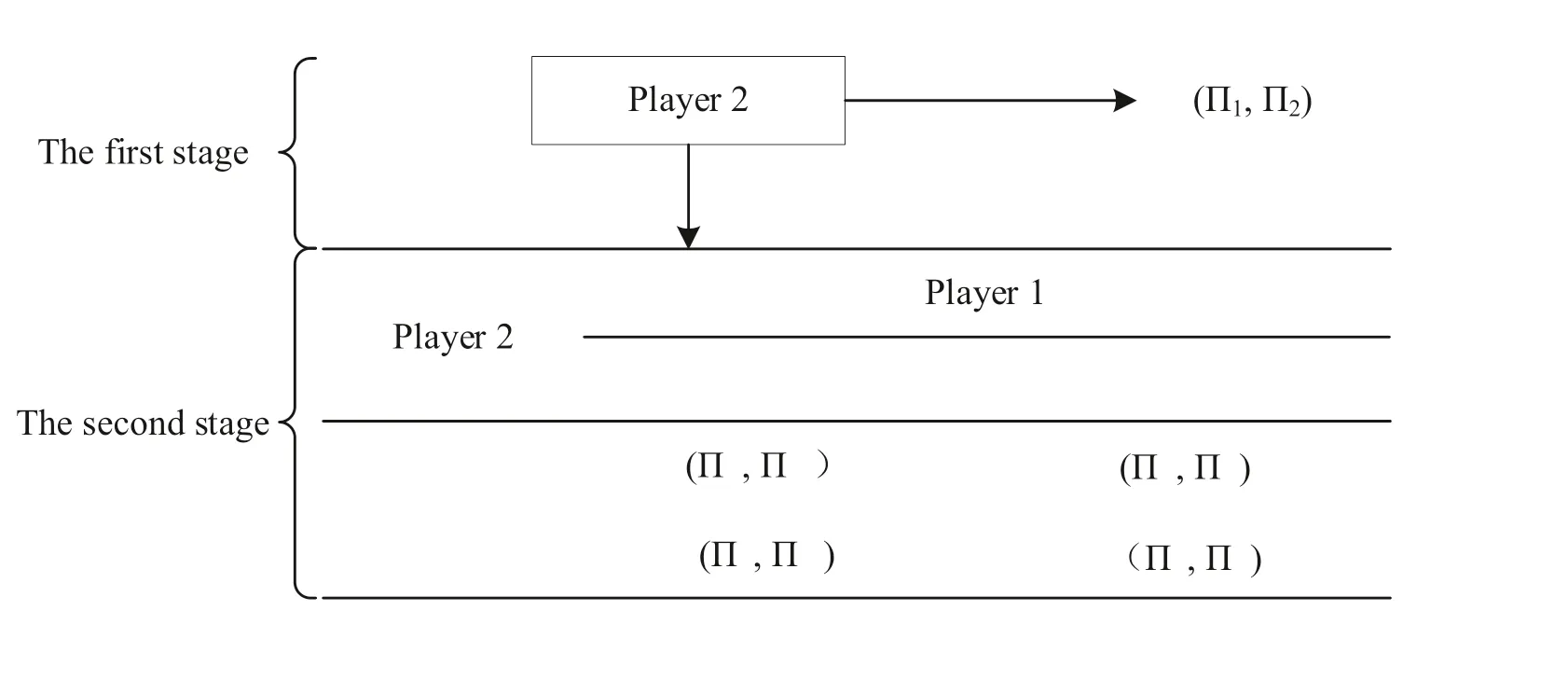
Fig.1 Two-stage game matrix with two players
Furthermore, in the CEM of the government and enterprises, the latter retain the right to choose whether to participate, and only if they do so can the CEM mechanism be produced.In the process of collaboration, the evolution of the government and enterprise strategies has a mutually promoting mechanism, and both sides seek the optimal strategy combination through continuous evolution, imitation, and learning, eventually reaching a stable state.Therefore, in this study the collaborative relationships were explored based on the perspective of evolutionary game theory, aiming at seeking ef fective measures to improve the performance of CEM between the government and enterprises.
4.2 Assumptions and Parameters
Our proposed model is based on the following assumptions:
(1) There are only two players in the evolutionary game system—local government and private enterprises(referred to as “government” and “enterprises”).
(2) Both the government and enterprises are bounded rational.Due to information asymmetry, they have limited abilities in rational cognition, analytical reasoning,and decision making.
(3) The government will always adopt active emergency management strategies toward social stability, security,and sustainable development.
(4) Enterprises are free to choose whether or not to participate in emergency management, respectively def ined as “participation” and “non-participation.” The game will enter the second stage if and only if the enterprise chooses the “participation” strategy in the f irst stage.
(5) In the second stage, enterprises have two strategies:“short-term participation” and “long-term participation.” Short-term participation refers to the temporary and random participation behavior of enterprises in emergency management, which often occurs in the emergency rescue stage (Yang and Zhang 2018).Long-term participation f irst refers to the enterprises’participation in the whole process of emergency management, including prevention, preparation, response,and recovery.In addition, long-term participation means that enterprises formally become partners of the government and ef fectively integrate with the government’s emergency forces.Long-term participation of enterprises will contribute more to emergency management, but it also means more cost.Correspondingly, the government also has two strategies to encourage enterprise participation in emergency management: “shortterm incentive” and “long-term incentive.” Compared with short-term incentive, long-term incentive means that the government provides emergency training to enterprises participating in emergency management to improve their participation ef ficiency.In addition, longterm incentive aims to reduce the participation cost of enterprises through government subsidies, thereby enhance their willingness and capabilities to continue to participate.The parameters of this evolutionary game model are def ined and described in Table 1.
4.3 Construction and Analysis of the Two-Stage Evolutionary Game Model
According to the two-stage evolutionary game framework presented in Fig.1 and the special nature of emergency management, this study took the government and enterprises as the players in dynamic and static games between the two sides and constructed a pay-of f matrix of two-stage evolutionary game with collaborative relationships in emergency management (Fig.2).
4.3.1 Analysis of the First Stage
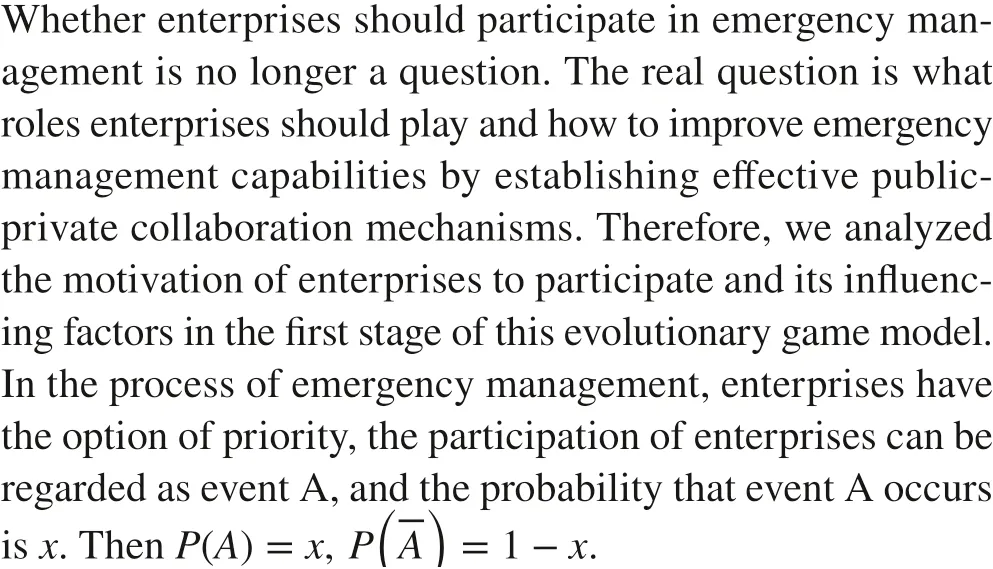
Previous studies have shown that enterprise participation in emergency management results from many inf luencing and decisive factors (Lu and Zhu 2022; Luo et al.2022;Zhang and Kong 2022).First, according to the theory of planned behavior (Luiza et al.2020), some inf luencing factors enhance enterprises’ willingness to participate, thus indirectly af fecting their strategy choices regarding participation.Specif ically, inf luencing factors comprise internal enterprise factors and external environmental factors.The former includes emergency resources, experience, and capabilities possessed by enterprises themselves, while the latter are external, particularly participation policies, emergency culture, and other participants.As an economic stakeholder of limited rationality, enterprises do not inevitably participate in emergency management even if their willingness to do so improves.The interaction mechanism of inf luencing factors on enterprises’ participation strategies is represented by the dotted line in Fig.3.

Table 1 Parameters and description

Fig.2 Pay-of f matrix of the government and enterprises
Second, decisive factors include extra benefit (𝜔) and cost (c) of participation for enterprises, which have a more signif icant and direct impact on their decision on whether to participate (Shi et al.2023).Therefore, whether enterprises participate in emergency management dependsultimately on the utility function of participation, which can be expressed as U(𝜔,c)=𝜔−c.If and only if U(𝜔,c)=𝜔−c>0, thenc=1 , and the enterprise will choose participation strategy, with the evolutionary game then entering the second stage.Otherwise,x=0, and the enterprise chooses not to participate because the cost outweighs the benef it; correspondingly, the government will choose the non-incentive strategy (Fig.3).

Fig.3 Evolution stability in stage 1.U(ω,𝒸)=ω −𝒸 refers to the utility function of enterprises in the f irst stage, ω refers to the extra benef it of enterprises’ participation in emergency management, 𝒸 refers to the extra cost of enterprises’ participation.
4.3.2 Analysis of the Second Stage
Incentives from the government have a signif icant impact on enterprise participation in emergency management(Luo et al.2022).They include a series of targeted policies, providing participation conveniences, and benef it such as f inancial rewards and technical or policy support, which are conductive to enterprises’ own economic development.Therefore, the second stage focuses mainly on sustainable collaboration between the government and enterprises in emergency management, considering the choice of government incentives and the choice of enterprises’ participation strategy, and exploring their behavior evolution rules and stability strategies.
Under the premise of bounded rationality, the evolutionary game of CEM between the government and enterprises is a process of mutual learning and dynamic self-adaptation.Therefore, we used the replicated dynamic equation to simulate their decision-making process.The benef it of the enterprises choosing the long-term participation strategy isEE1:
The benef it of the enterprises choosing the short-term participation strategy isEE2:
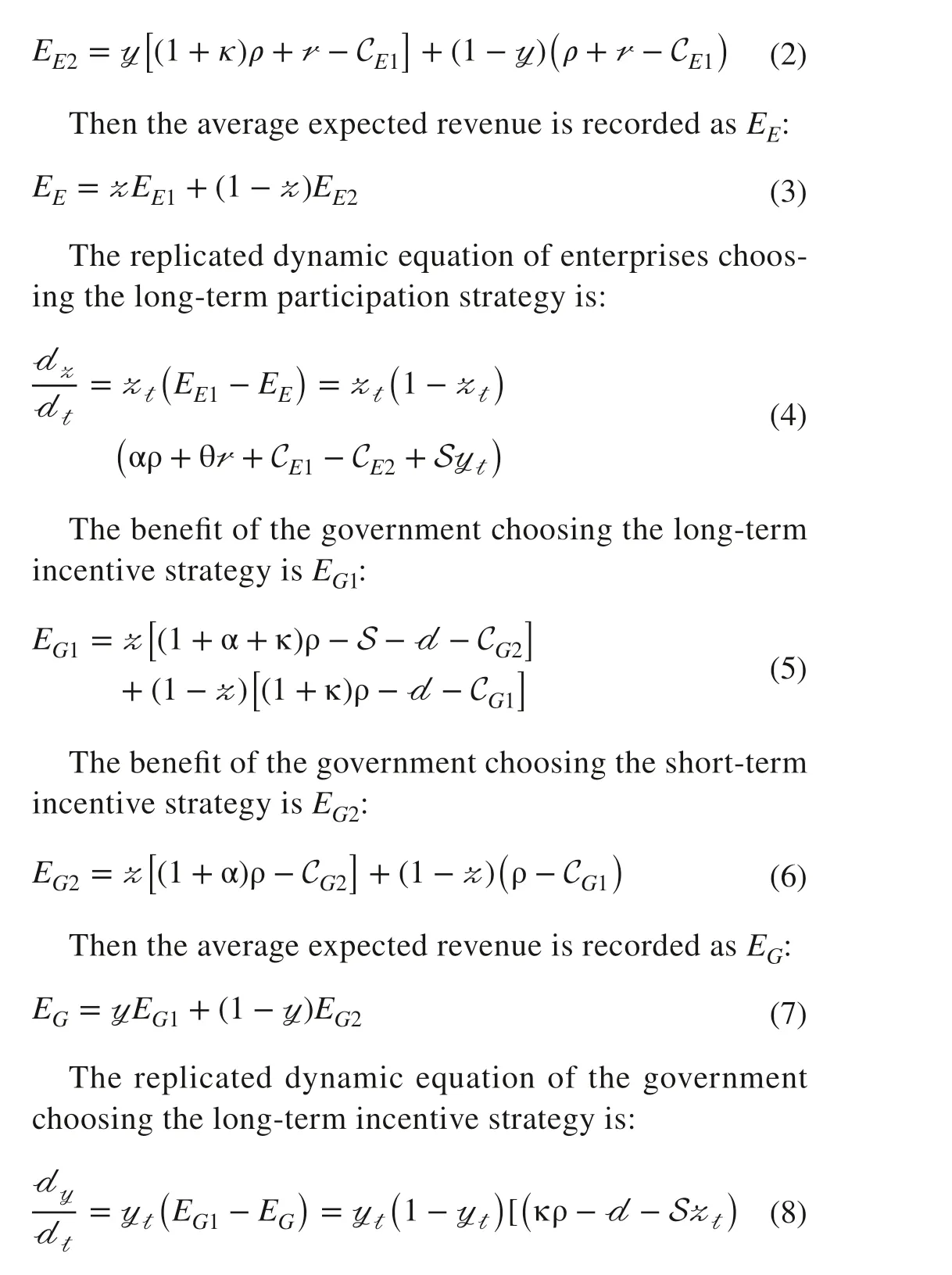
Therefore, the two-dimensional dynamic system of the evolutionary game of CEM between the government and enterprise is:

According to the evolutionary game theory, if Dℯ&#x1d4c9;(J)>0 and T&#x1d4c7;(J)<0 are satisfied at equilibrium points of the replicated dynamic equations, they constitute ESS of the system.For each equilibrium point, the determinant and trace of the system are shown in Table 2.
According to the above hypothesis, as well as the determinant and trace of equilibrium points in Table 2, the local stability of this evolutionary game system can be judged.Specif ically:

4.3.3 Model Stability Test
The replicated dynamic equation needs to meet stability requirements to ensure it will not signif icantly change due to slight shifts in parameters.We therefore tested stability before numerical analysis using the stability analysis method suggested by Wei et al.( 2012) and Sun et al.( 2023): the sensitivity index is calculated by changing 10% of key factors;and if the sensitivity index is less than 1, the model is stable.The sensitivity index is calculated as follows:
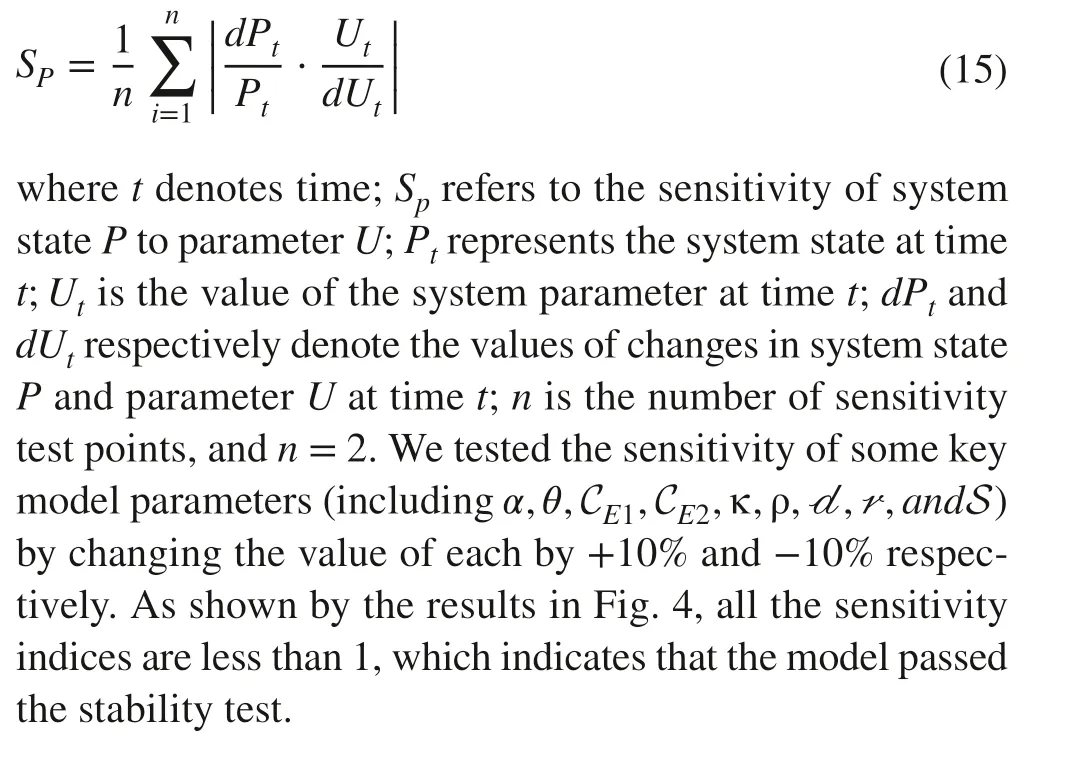

Table 2 Dℯ&#x1d4c9;(J) and T&#x1d4c7;(J) in equilibrium points
5 Numerical Analysis
This section analyzes the system’s evolution path under different situations by adopting SD simulation methods, as well as the ef fects of cost dif ference, government subsidies, reputation benef it, and training cost on the evolutionary game paths of long-term participation and short-term participation, thereby further exploring the collaboration mechanism between enterprises and governments.
5.1 Numerical Analysis Under Dif ferent Situations
To show the dynamic evolution process of enterprise and government strategy selection more intuitively, we adopted numerical simulation in this study, using MATLAB to simulate the dynamic evolution trajectory from initial point to equilibrium point in several situations.The simulation results are shown in Fig.5.
Situation (a): When&#x1d6fc;&#x1d70c;+&#x1d703;&#x1d4c7; Situation (b): When&#x1d6fc;&#x1d70c;+&#x1d703;&#x1d4c7;+S Situation (c): When&#x1d6fc;&#x1d70c;+&#x1d703;&#x1d4c7;>CE2−CE1,&#x1d705;&#x1d70c;<&#x1d4b9;+S ,and&#x1d6fc;=0.4,&#x1d703;=0.3,CE1=10,CE2=18,&#x1d705;=0.7,&#x1d70c;=5,&#x1d4b9;=2,&#x1d4c7;=10,S=2, the evolution step of the system is shown in Fig.5 c.In this situation, the sum of emergency management benef it and reputation benef it exceeds the incremental cost of participation, leading enterprises to choose long-term participation strategy regardless of which incentive strategy is pursued by the government.For the government, however, the subsidies and emergency management training cost paid to enterprises pursuing long-term participation exceed the incremental benef it for emergency management brought by trained enterprises.Therefore, government will pursue the shortterm incentive strategy, and the evolution result of thesystem f inally converges to (1, 0).In this situation, the ESS is {long-term participation, short-term incentive}.Situation (d): When&#x1d6fc;&#x1d70c;+&#x1d703;&#x1d4c7;+S>CE2−CE1,&#x1d705;&#x1d70c;>&#x1d4b9;+S , and&#x1d6fc;=0.5,&#x1d703;=0.6,CE1=10,CE2=16,&#x1d705;=0.8,&#x1d70c;=5,&#x1d4b9;=1,&#x1d4c7;=10,S=1, the evolution step of the system is shown in Fig.5 d.This situation entails that the incremental benef it of enterprises’ participation in emergency management exceeds the training cost and subsidies paid by the government.Consequently, whichever strategy enterprises choose, the government will pursue long-term incentive strategy.For enterprises, the sum of incremental emergency management benef it, reputation benef it, and government subsidies exceeds the extra cost of pursuing long-term participation.Therefore, enterprises will choose the long-term participation strategy, and the evolution result of the system f inally converges to (1, 1),the ESS under this situation is {long-term participation,long-term incentive}. Fig.5 Evolution steps of the system under dif ferent situations With the initial probability unchanged, we analyzed the ef fect of each parameter on the evolutionary game path.The results of the numerical analysis are shown in Fig.6. 5.2.1 Ef fect of Enterprise Participation Cost on Evolution Results Fig.6 Ef fect of parameter variation on evolution results.Δ&#x1d4b8; refers to the incremental cost of enterprises choosing long-term versus short-term participation strategy. Other parameters are:&#x1d6fc;=0.6,&#x1d703;=0.4,κ =0.6,ρ=5,&#x1d4b9;=6,&#x1d4c7;=10,S=15.The initial probability is&#x1d4cf;0 =0.5and&#x1d4ce;0 =0.5 ; the incremental cost of enterprises choosing long-term versus short-term participation is Δ&#x1d4b8;=CE2−CE1, varying between [0, 10]; and the evolution result of the system is shown in Fig.6 a.The result of the numerical analysis shows that if 0 ≤Δ&#x1d4b8;≤6 , an enterprise’s ESS converges to long-term participation, and the evolution speed decreases as Δ&#x1d4b8; rises; if Δ&#x1d4b8;≥8 , then the enterprises’ESS converges to short-term participation, and the evolution speed increases as Δ&#x1d4b8; rises.Compared with short-term participation, enterprises are willing to adopt long-term participation strategy when the cost increment of long-term participation is small.On the contrary, as the cost increment of long-term participation increases gradually, enterprises will adopt short-term participation strategy. 5.2.2 Ef fect of Reputation Benef it on Evolution Results Other parameters are:&#x1d6fc;=0.6,&#x1d703;=0.4,κ =0.6,ρ=5,&#x1d4b9;=6,CE2=20,CE1=10,S=15.The initial probability is&#x1d4cf;0 =0.5and&#x1d4ce;0 =0.5 ; the value of the reputation benef it &#x1d4c7;obtained by enterprises for participating in emergency management varies within the range [0, 20], and the evolution result of the system is shown in Fig.6 b.The result shows that if 0 ≤&#x1d4c7;≤15 , the enterprise’s ESS converges to shortterm participation, and the evolution speed decreases as &#x1d4c7;rises; If &#x1d4c7;≥20 , the enterprise’s ESS converges to long-term participation, and the evolution speed increases as &#x1d4c7; rises.This indicates that increasing reputation benef it incentivize enterprises to pursue long-term participation; otherwise,they will adopt the short-term participation strategy.In other words, reputation benef it has a positive impact on enterprises’ strategy choice. 5.2.3 Ef fect of Government Subsidies on Evolution Results Other parameters are:&#x1d6fc;=0.6,&#x1d703;=0.4,κ =0.6,ρ=15,&#x1d4b9;=6,CE2=20,CE1=10,&#x1d4c7;=10.The initial probability is &#x1d4cf;0 =0.5and&#x1d4ce;0 =0.5 ; the value of government subsidies S varies within the range [0, 10]; and the evolution result of the system is shown in Fig.6 c.The result shows that if 0 ≤S ≤2 , the government’s ESS converges to long-term participation, and the evolution speed decreases as S rises;If S ≥4 , the government’s ESS converges to short-term participation, and the evolution speed increases as S rises.For enterprises, their ESS converges to long-term participation,and the evolution speed increase as S rises (Fig.6 d).The results indicate that as the government subsidies increase,the government tends toward pursuing the short-term incentive strategy.On the contrary, government subsidies have positive ef fect on enterprises’ participation strategy, and the more subsidies provided by the government, the less time it takes for enterprises to converge to long-term participation. 5.2.4 Ef fect of Training Cost on Evolution Results Other parameters are:&#x1d6fc;=0.6,&#x1d703;=0.4,κ =0.6,ρ=5,CE2=20,CE1=10,&#x1d4c7;=10,S=15.The initial probability is &#x1d4cf;0 =0.5 and &#x1d4ce;0 =0.5 ; training cost &#x1d4b9; paid by the government varies within the range [0.5, 3]; and the evolution result of the system is shown in Fig.6 e.Some cases in this situation converge slowly or fail to converge to a stable state.Therefore, to show the long-term trend, evolution time &#x1d4c9; is extended to [0, 50], and the evolution result of the system is again shown in Fig.6 e.The results indicate that if &#x1d4b9;≥2 ,the government’s ESS converges to short-term incentive strategy; If 0.5 ≤&#x1d4b9;≤1.5 , there is less stability in whether the government chooses to pay the emergency management training cost for enterprises. With the complexity and impact of various emergencies worldwide continuing to increase, enterprise participation has become an indispensable part of ef fective response to emergencies.However, the performance of enterprises participating in emergency management needs to be further improved.Considering the challenges of enterprise participation and government incentives, this study constructed a two-stage evolutionary game model based on stakeholders’bounded rationality to analyze the behavioral evolution characteristics of both participants in the emergency management system, and analyzed the system’s evolution path under dif ferent situations using SD simulation, thereby exploring the collaboration mechanism between the government and enterprises.We found that although enterprise participation in emergency management is af fected by both inf luencing and decisive factors, their f inal decision depends on the utility function U(&#x1d714;,&#x1d4b8;) : if and only if U(&#x1d714;,&#x1d4b8;)=&#x1d714;−&#x1d4b8;>0, an enterprise will choose the participation strategy and enter the emergency management system, initiating the second stage of the evolutionary game. The simulation results reveal that in the second stage,there are two situations in which the government will choose long-term incentive strategy: the f irst is that although the enterprises adopt short-term participation strategy, the incremental benef it of enterprises supporting emergency management after training exceeds the training cost paid by the government; the second is that the enterprises adopt longterm participation strategy, and the incremental benef it of enterprise participation in emergency management exceeds the training cost and subsidies paid by the government.Correspondingly, there are also two situations in which the enterprises will choose long-term participation strategy:the f irst is that although the government adopt short-term incentive strategy, the sum of emergency management benef it and reputation benef it exceeds the incremental cost of long-term participation; the second is that the government adopt long-term incentive strategy, and the sum of incremental emergency management benef it, reputation benef it,and government subsidies exceeds the extra cost of pursuing long-term participation. In addition, if other factors remain unchanged and the cost increment of long-term participation is low, the enterprises’ ESS converges to long-term participation, whereas as emergency management cost increases, enterprises tend to opt for short-term participation.With the increase of reputation benef it, enterprises will turn their ESS from short-term participation into long-term participation.In other words, reputation benef it has a positive impact on enterprises’ strategy choice.Similarly, government subsidies such as tax reduction and preferential policies incentivize enterprises to pursue a long-term participation strategy.If other factors remain unchanged, the increase in government subsidies will increase the evolution speed of enterprises’ ESS converging to long-term participation,but the ESS of the government simultaneously converges to short-term incentive.Finally, when the cost of emergency management training is low, there is less stability in whether the government chooses to pay the training cost for enterprises, but as the training cost rises, the ESS of the government quickly converges to short-term incentive. Overall, if and only if the ESS of the system converges to {long-term participation, long-term incentive},the benef it of CEM for both the government and enterprises outweigh the extra cost they paid.Therefore, the most important thing is that the government should adopt ef fective measures to promote the continuous participation of enterprises in emergency management.First, the government can provide continuous f inancial subsidies and promotion incentive for enterprises’ participation.Financial subsidies such as tax breaks can directly reduce the cost of enterprise participation, promotion incentive such as honor system can improve the reputation benef it of enterprise participation, and both f inancial subsidies and promotion incentive can promote continuous participation behavior of enterprises in emergency management.Second, the government also needs to optimize the communication mechanisms between itself and enterprises, and provide diversif ied participation channels and information support for enterprises.This can not only reduce the cost of coordination for both the government and enterprises in CEM, but also improve the benef it of CEM between the government and enterprises, so as to establish long-term collaborative relationships in emergency management.Third, the government should also provide systematic emergency training for enterprises to improve their capabilities to participate in emergency management, thereby giving full play to the advantages and potential of enterprise participation.For enterprises, since corporate social responsibility can positively and signif icantly inf luence sustainable competitive advantages (Wang et al.2023),they should strengthen their emergency capabilities in daily operation and management from the perspective of corporate social responsibility, establish a good collaborative relationship with the government, and participate in the whole process of emergency management.In this way,the participation of enterprises can bring more benef it to themselves and the society. Through two-stage evolutionary game modeling and simulation analysis of CEM between the government and enterprises, this study not only enriches the emergency management literature, but also provides a new theoretical perspective and methodological reference for future research on the multi-agent CEM mechanism.Meanwhile, the results provide important references for government measures promoting CEM performance through enterprise participation.However, this study also has some limitations that future research should address.First, while this study considers only enterprises and governments, CEM in practice also includes social organizations, citizens, media, and other stakeholders.Therefore, future research needs to comprehensively analyze collaboration relationship among multiple agents in the emergency management process.Second, as a complex system, the government-enterprise collaborative relationship in emergency management is af fected by many factors that were given little attention in this study.Some inf luencing factors, such as relevant regulations and polices need to be further discussed in future research.In particular, the introduction of information and communication technology such as blockchain, 5G, and big data of fers great potential to improve CEM capability with multi-agent participation.More studies are needed to further explore how the application of these technologies af fects the game strategy choice of enterprises and governments for emergency management. FundingThis work was supported by the Major Project of National Social Science Foundation of China (Grant No.21&ZD166), the National Social Science Foundation of China (Grant No.22VRC200),and the China Scholarship Council (CSC, Grant No.202206420064). Open AccessThis article is licensed under a Creative Commons Attribution 4.0 International License, which permits use, sharing, adaptation, distribution and reproduction in any medium or format, as long as you give appropriate credit to the original author(s) and the source,provide a link to the Creative Commons licence, and indicate if changes were made.The images or other third party material in this article are included in the article's Creative Commons licence, unless indicated otherwise in a credit line to the material.If material is not included in the article's Creative Commons licence and your intended use is not permitted by statutory regulation or exceeds the permitted use, you will need to obtain permission directly from the copyright holder.To view a copy of this licence, visit http:// creat iveco mmons.org/ licen ses/ by/4.0/.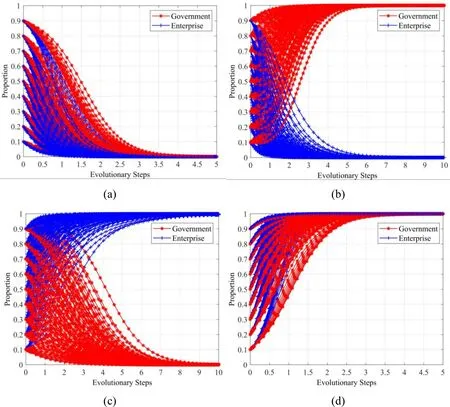
5.2 Numerical Analysis of Parameter Variation

6 Conclusion and Future Prospects
杂志排行
International Journal of Disaster Risk Science的其它文章
- The 2023 Earthquake in Türkiye and Implications for China’s Response to Catastrophe
- Reasoning Disaster Chains with Bayesian Network Estimated Under Expert Prior Knowledge
- A Generalized Accelerated Failure Time Model to Predict Restoration Time from Power Outages
- The Dynamics of Interorganizational Collaboration in Disaster Management: A Network Study Based on Flood Disasters in China
- Identify Landslide Precursors from Time Series InSAR Results
- A Deep Learning Application for Building Damage Assessment Using Ultra-High-Resolution Remote Sensing Imagery in Turkey Earthquake
